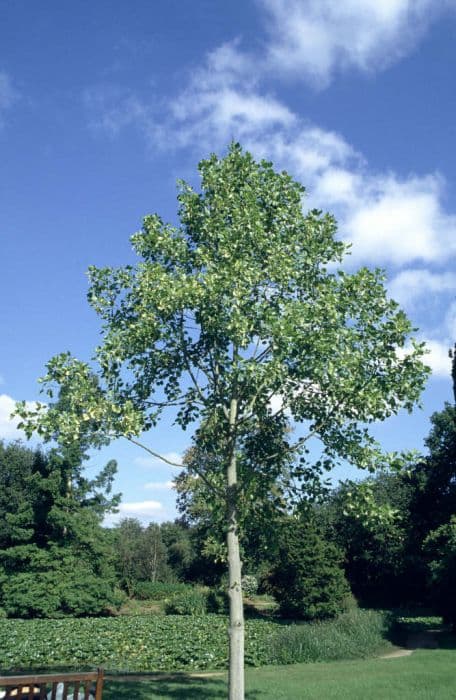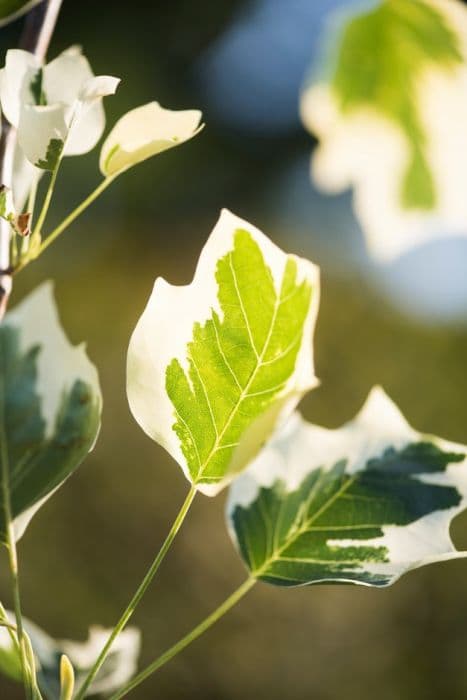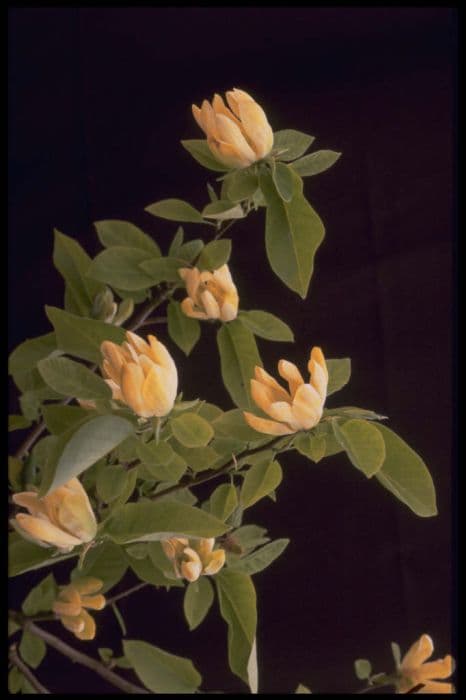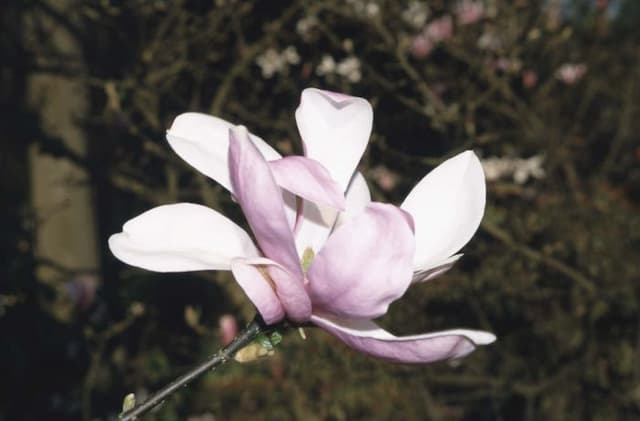Yulan Magnolia Magnolia denudata 'Giubiasco'

ABOUT
The Magnolia denudata 'Giubiasco' is a captivating plant known for its large, showy, goblet-shaped flowers that appear before the leaves in early spring. These blossoms are typically pure white, adding an air of elegance to the scenery. The blooms are quite fragrant, filling the surrounding area with a sweet, pleasing scent that heralds the arrival of warmer days. The leaves of 'Giubiasco' are glossy and deep green, emerging after the flowers as a lush backdrop to the striking floral display. The foliage takes on a broad, oval shape with a smooth texture, creating a dense, verdant canopy throughout the growing season. In fall, the leaves may turn a golden-yellow color, providing a warm, autumnal display before they shed for the winter. 'Giubiasco' is a cultivar that enthusiasts cherish for its aesthetic contributions to gardens and landscapes, with its alluring blossoms being a focal point for many springtime displays. Despite the absence of details on its dimensions, it's clear that 'Giubiasco' commands attention with its delightful appearance that changes and progresses throughout the seasons.
About this plant
 Names
NamesFamily
Magnoliaceae
Synonyms
Yulan Magnolia, Lily Tree, Tulip Magnolia
Common names
Yulania denudata, Magnolia heptapeta, Magnolia biondii.
 Toxicity
ToxicityTo humans
Yulan magnolia is not commonly known to be toxic to humans. There are no well-documented symptoms of poisoning from ingesting parts of this plant, as it is not typically regarded as a poisonous species.
To pets
Yulan magnolia is not commonly known to be toxic to pets either. Like in humans, there are no widely recognized symptoms of poisoning in pets from ingesting this plant, suggesting it is largely safe for animals in a domestic setting. However, it is always prudent to be cautious and prevent pets from eating plants, as individual animals might have unique sensitivities.
 Characteristics
CharacteristicsLife cycle
Perennials
Foliage type
Deciduous
Color of leaves
Green
Flower color
White
Height
15-20 feet [4.6-6 meters]
Spread
10-15 feet [3-4.6 meters]
Plant type
Tree
Hardiness zones
5
Native area
China
Benefits
 General Benefits
General Benefits- Aesthetic Appeal: Magnolia denudata, known commonly as Yulan Magnolia, has large, showy white flowers that are highly valued for their beauty and can enhance the visual appeal of any garden or landscape.
- Sensory Experience: The fragrant blossoms of the Yulan Magnolia provide a delightful scent that can enrich the sensory experience of a space.
- Habitat for Wildlife: It can attract pollinators such as bees and birds, providing them with nectar and assisting in maintaining a healthy ecosystem.
- Seasonal Interest: The Yulan Magnolia offers seasonal interest with its early spring blooming, which can signal the arrival of warmer weather.
- Shade Provider: As a tree, it can offer shade in gardens and can help in reducing local temperatures and providing a cooler environment during hot seasons.
- Erosion Control: The root system of the tree can help stabilize soil and prevent erosion in certain landscapes.
 Medical Properties
Medical Properties- This plant is not used for medical purposes.
 Air-purifying Qualities
Air-purifying QualitiesThis plant is not specifically known for air purifying qualities.
 Other Uses
Other Uses- Magnolias can be used in landscape design as a specimen tree that provides a focal point with its striking flowers and attractive form.
- The wood of magnolias is sometimes used in the creation of furniture or small wooden objects due to its workability and grain patterns.
- Floral designers often use magnolia branches and blooms in large, dramatic arrangements for events or as part of interior decor.
- The flowers of magnolia trees can be crystallized and used as edible decorations for desserts and various culinary presentations.
- Magnolia leaves can be used as a natural mulch to suppress weeds and retain soil moisture in garden beds.
- Dried magnolia leaves and seed pods are commonly used in crafting, for example in wreaths or as part of dried floral arrangements.
- The large, sturdy leaves of magnolia can be used as temporary serving plates for outdoor dining experiences or eco-friendly events.
- In photography and film, magnolia trees provide a lush and romantic backdrop, especially when in full bloom.
- Extracts from magnolia flowers are sometimes used in perfumery, giving a rich and exotic scent to fragrances.
- Magnolia petals, due to their thick and waxy nature, can be used in artists' installations and sculptures, sometimes dyed to create visual impact.
Interesting Facts
 Feng Shui
Feng ShuiThe Yulan magnolia is not used in Feng Shui practice.
 Zodiac Sign Compitability
Zodiac Sign CompitabilityThe Yulan magnolia is not used in astrology practice.
 Plant Symbolism
Plant Symbolism- Purity: Magnolias often symbolize purity due to their white flowers and are commonly associated with the purity of nature.
- Nobility: The magnificence and stature of the Magnolia tree have led it to be a symbol of nobility and dignity.
- Perseverance: As an early bloomer that can withstand harsh conditions, Magnolias represent perseverance and endurance.
- Feminine Beauty: The delicate, yet strong appearance of Magnolia flowers has become a symbol for feminine beauty and gentleness.
- Love of Nature: With its lush blooms and green foliage, the Magnolia tree signifies a love and appreciation for the natural world.
 Water
WaterThe Yulan magnolia should be watered deeply to ensure the soil is moist but not soggy, which often equates to about 1-2 gallons per week for young trees, adjusting for rainfall and temperature. During the growing season, increase the water to 2-4 gallons per week. In the absence of rainfall, water mature trees deeply every two weeks. Adjust water needs for the tree based on soil conditions and climate; well-draining soil will require less frequent watering, while hot, dry weather will require more. It is crucial to not let the soil dry out completely, but also to avoid waterlogging the tree.
 Light
LightYulan magnolia thrives in full sun to partial shade. The ideal location would provide morning sunlight with some afternoon shade, especially in hotter climates. To keep blossoms from fading quickly, avoid placing the magnolia in an area with intense afternoon sun.
 Temperature
TemperatureFor the Yulan magnolia, the ideal temperature range is between 60°F and 80°F. It is hardy in USDA zones 5 through 8, tolerating minimum winter temperatures down to -20°F. Extreme heat above 90°F can be stressful for the plant, so providing shade or water during heat waves is beneficial.
 Pruning
PruningPrune the Yulan magnolia to remove dead or damaged wood and shape the tree, best done after flowering in spring to avoid cutting off next year's buds. Light shaping and removal of crossed branches can be done to maintain a healthy structure. Major pruning should be undertaken sparingly as magnolias do not recover well from heavy cutting.
 Cleaning
CleaningAs needed
 Soil
SoilYulan Magnolia thrives in rich, well-drained soil with a mix of loam, peat, and sand to provide aeration. Aim for a pH between 5.5 and 6.5, adding organic matter to increase acidity and nutrient content if needed. Ideal soil should retain moisture without becoming waterlogged.
 Repotting
RepottingYulan Magnolia doesn't require frequent repotting; do it every 3 to 5 years. Younger plants may need repotting more often to accommodate growth, but mature plants prefer to be undisturbed.
 Humidity & Misting
Humidity & MistingYulan Magnolia prefers moderate to high humidity levels but is adaptable to average outdoor conditions. It does not require specific humidity adjustments when grown in its natural outdoor environment.
 Suitable locations
Suitable locationsIndoor
Ensure bright light, adequate space, and consistent watering.
Outdoor
Plant in well-drained soil, partial shade to full sun.
Hardiness zone
6-9 USDA
 Life cycle
Life cycleMagnolia denudata 'Giubiasco', commonly known as Yulan Magnolia, begins its life as a seed which germinates in moist, well-drained soil with sufficient sunlight and warmth. The seedling emerges with a pair of starter leaves and subsequently develops true leaves as it grows into a young plant; this juvenile phase can last several years as the plant establishes itself. As the Yulan Magnolia matures, it develops a sturdy trunk and extensive root system, and begins to produce its characteristic large, white fragrant flowers in early spring before the leaves appear, signaling the reproductive stage. After pollination, typically by beetles attracted to the flowers, the plant produces cone-like fruit that releases red seeds when mature. The Magnolia reaches peak maturity and maximum size in several decades and can live for well over a century, with flowering every spring followed by seed production. Throughout its life, the Yulan Magnolia may face cycles of growth, dormancy in winter, and recovery from environmental stresses such as drought or pest damage.
 Propogation
PropogationPropogation time
Spring-Early Summer
The most popular method of propagating Magnolia denudata 'Giubiasco', commonly known as the Yulan magnolia, is through semi-hardwood cuttings. This process typically takes place in late summer. To propagate by cuttings, a gardener should select healthy, semi-hardwood stems that have current season's growth and cut them into lengths of 4 to 6 inches (about 10 to 15 centimeters). Each cutting should have at least two or three sets of leaves. The lower sets of leaves are removed, and the cut end is often treated with a rooting hormone to encourage root growth. The cuttings are then planted in a well-draining rooting medium, such as a mixture of peat and perlite, and kept moist in a warm, shaded environment until roots have developed, which usually takes several weeks. Once the cuttings have rooted and show signs of growth, they can be gradually acclimatized to outdoor conditions before permanent planting.







![Magnolia [Black Tulip]](/_next/image?url=https%3A%2F%2Fplants-admin.emdemapps.com%2Fimages%2Fplants%2F%2Fimages%2F604b590290fc7.png&w=640&q=75)

